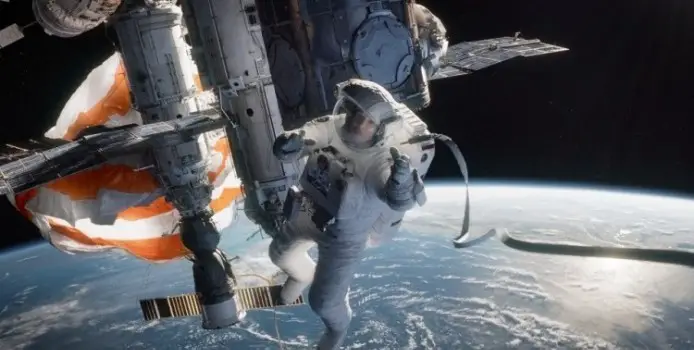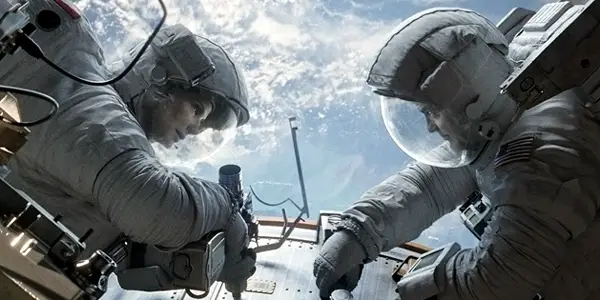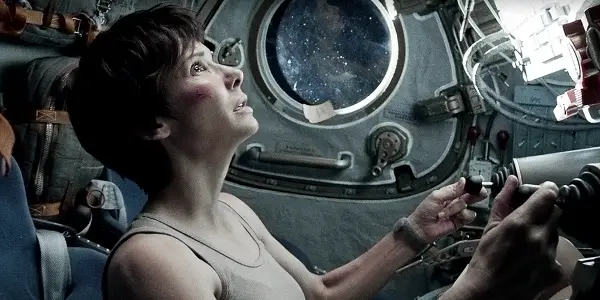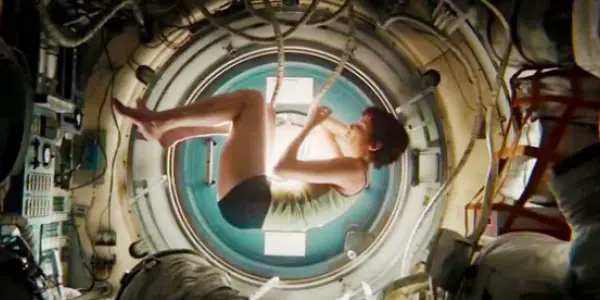GRAVITY: Does the Multi-Oscar Winning Film Live Up to the Hype?

Kim is an editor and contributor for FilmInquiry. As a…
When I saw the first preview of this film, it appealed to me as a sci-fi thriller fan. I had every intention of going to the theaters to see it, but alas, I waited too long. Meanwhile, Gravity won several Academy Awards including Best Director, Best Cinematography, Best Visual Effects, and Best Original Score. Eventually watching at home on my 40 inch screen, I likely didn’t gain the full experience of the cinematography, score, and overall feel I would have on a big screen. But there was still much of the film with which I had issues that weren’t an effect of my scaled-down viewing.
Opening with a breathtaking panorama of Earth from outer space, we are introduced to veteran astronaut Matt Kowalski (George Clooney) listening to country music and quipping with the fellas down in Houston and Dr. Ryan Stone (Sandra Bullock), a medical engineer on her first shuttle mission. Only moments into the film, the astronauts are faced with word that an explosion has just occurred at a Russian satellite and a cloud of debris is headed their way.
After their initial crash with the satellite debris, Dr. Stone and Commander Kowalski begin the difficult task of traveling through open space to a nearby station and somehow get back to Earth.
Lots of Floating Around
As Kowalski and Stone appear to be close to the space station which could take them home, the news comes that Ryan Stone is almost out of oxygen. In a last attempt, Kowalski thrusts his jet pack and allows them both to be flung at the station. But things just get trickier from there, as another bout of debris throttles the two away from each other, leaving Stone on her last breath and Kowalski desperately telling her to make it inside the station. This scene went on far too long to keep me in suspense; after a few minutes I found myself yelling at the screen, “Get inside already!” and “Why haven’t you passed out yet?”

Though it was an average length film, the slow moving plot had me uncomfortably pushing for Ryan Stone to hurry up! Another example of this was inside the space station where she floated fretting about Matt Kowalski’s silence when she should be preparing herself to shuttle home. Lest I forget to mention the obvious Zero-G flames coming from a control panel that she conveniently neglects to notice before the entire section of the station bursts into a full on fire.
Earlier on in the story, Dr. Stone relates her heartbreaking story to Matt about her daughter’s tragic death. While I empathized with her as a character, I couldn’t help but wonder – then what is there on Earth to live for? She had no photo of her daughter and no mention of any other loved ones back home. The script and overall story seemed underdeveloped and flimsy.
That also got me thinking about the lack of realism in the film. Examples of this: Ryan accurately using a fire extinguisher as a jet propulsion; no burn marks from flames or cuts/scrapes from impact of debris; she hallucinates when she merely lowers the oxygen level, but had no apparent problem breathing CO2 for a while as she searched for the entrance to the space station.
What I Can Appreciate
The film was short, running only 91 minutes. This was a very redeeming quality as I don’t think I could sit through much more. I did, however, take note of the applause-worthy acting on the part of our two leads. Using what they were given, they drove the emotion and telling of the story as only Academy Award winning actors can do. Not being Sandra Bullock‘s biggest fan, I was impressed by her devotion to the despair of a mother losing her child and tension of her situation.
The visuals of space and the attention to detail of the Earth were extraordinary, even on a small screen. What added to this were the first and third person camera views. We see Ryan Stone floating, spinning out of control. Then as the music intensifies, we’re suddenly given only the frantic breathing and confusion inside her suit, until we are literally in her body, seeing the Earth and stars spin before our eyes. I appreciated this directing technique as a way for the audience to empathize with her character and feel the desperation of not knowing which way is up.
Audiences who saw the film in 3D had an advantage in certain scenes. Inside the space station were objects intentionally floating toward the screen. Whether or not the 3D effect was achieved, I cannot say.
As far as the award for best score, I could not agree more. The ambiance created by the dramatic orchestral music amplified the experience. Even the moments of silence added suspense in the depths of space. And the other songs on the soundtrack balanced out the emotions portrayed in the film.

Obvious Message
Similar to others in its genre, Apollo 13 (1995) and Armageddon (1998) for example, the icons throughout were in tune with typical astral science fiction films. The visuals of their view of Earth and the sun, objects that lazily drift away in space, even the sunlight reflecting off the helmets gave it that celestial feel.
An overarching theme began to develop as Dr. Stone spent time alone in the depths of space. Mother Earth’s protection, mother and child separated at birth – these elements are reminiscent in the story of her daughter’s sudden death and her lonely predicament in space. However, Cuarón shoves this message in our face with the scene of Sandra Bullock in the fetal position with the tether symbolic of an umbilical cord. As she drifts to sleep later in the film, the sound of a baby crying comforts her. Ryan Stone reverts back to the womb and becomes meek and frail, signifying the fragility of life.

Bottom Line
Gravity earned its Oscars as a visually stunning and well managed film. While these qualities were brilliant, this film was not one I would recommend highly. As long as you’re not easily aggravated and have an hour and a half to spare, give it a try.
Did you see the film in theaters? Do you agree that the film deserved all the praise? Let me know in the comments!
Does content like this matter to you?
Become a Member and support film journalism. Unlock access to all of Film Inquiry`s great articles. Join a community of like-minded readers who are passionate about cinema - get access to our private members Network, give back to independent filmmakers, and more.
Kim is an editor and contributor for FilmInquiry. As a movie nerd from Buffalo, NY, her passion for film and t.v. motivates her enjoyment of reading and writing. She hopes to polish her style and publish original, thought-provoking articles about some of her favorite and not-so-favorite films. Thanks for reading!













